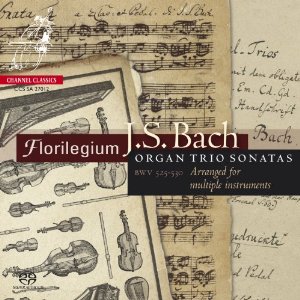 |
 |
|


alternatively
CD: MDT
AmazonUK
AmazonUS
|
Johann Sebastian BACH (1685-1750)
Organ Trio Sonatas
Trio Sonata in G major (originally E flat major), BWV 525 [13:29]
Trio Sonata in G major, BWV 530 [13:35]
Trio Sonata in D major (originally C major), BWV 529 [13:05]
Trio Sonata in E minor, BWV 528 [9:48]
Trio Sonata in G minor (originally D minor), BWV 527 [16:07]
Trio Sonata in E minor (originally C minor), BWV 526 [9:45]
 Florilegium (Rodolfo Richter (violin/viola); Reiko Ichise (viola
da gamba); Jennifer Morsches (cello/piccolo cello); Eligio Quinteiro
(lute); James Johnstone (harpsichord)/Ashley Solomon (flute)
Florilegium (Rodolfo Richter (violin/viola); Reiko Ichise (viola
da gamba); Jennifer Morsches (cello/piccolo cello); Eligio Quinteiro
(lute); James Johnstone (harpsichord)/Ashley Solomon (flute)
rec. 29-31 May 2007, St Martin’s Church, East Woodhay, Newbury
 CHANNEL CLASSICS
CHANNEL CLASSICS  CCSSA27012
[75:53] CCSSA27012
[75:53]
|
|
|
Since their formation in 1991, Florilegium’s status as
one of Britain’s most outstanding period instrument ensembles
has been established both on the concert
podium and in numerous recordings. This is by no means the
first time Bach’s organ Trio Sonatas have been
arranged for instrumental forces. The results of such recordings
have not all been considered a success,
but there are already some very nice versions to be had. London
Baroque on the BIS label for instance (see review),
by chance recorded at the same location as this Florigelium
disc, and some more recent challengers from CPO and Challenge
Classics (see review).
With most points of similarity it would be daft not to make
a comparison between London Baroque on BIS-CD-1345 and this
Florilegium recording. Presented in order of BWV number, London
Baroque has a more uniform sound through the cycle, the strings
and harpsichord combination creating a nice concerto grosso
feel. There is plenty of energy and style in the playing, the
recording is sweetly balanced and there’s a delicious
feel of air around the players. There is also contrast, with
the introduction of a chamber organ to substitute the harpsichord
in BWV 528 and 530. I agree with Kirk McElhearn
that the music seems as if written exactly for this combination,
and there isn’t much more to be asked from such a production.
Florilegium’s disc has the advantage of 5.0 SACD surround
sound, but leaving that aside for a moment their recording is
a tad warmer than the BIS disc, the instruments a touch closer
but by no means uncomfortably so. The immediate difference is
of course in the instrumentation, the flute topping in BWV
525 and 526 changing the chemistry of the music a
good deal. Florilegium’s task here is trickier than London
Baroque’s, with the homogeny of line between strings along
being closer in spirit to that of a set of organ pipes. The
musical conversation is no longer between equals, but between
like-minded characters who are nonetheless distinctive in terms
of their voice. The gut reaction is to prefer the strings-only
setting, but with playing of sensitivity and amicable lyricism
the ear soon warms to Florilegium’s approach. I’m
listening to the Adagio second movement of BWV 525
with these comments in mind, but they are valid throughout.
Where Florilegium also score is in the imagination they have
applied in contrasting instrumentation between works. Taken
in playing order, BWV 530 is strings and harpsichord
only, the latter seeming beefed up somewhat, and the viola da
gamba having a more supporting role with its unadorned bass
line. BWV 529 is transposed from C into the flute’s
key of D major and turned into a flute sonata, the interplay
between harpsichord and virtuoso wind sound sounding every bit
like one of Bach’s canon of this genre. The central Largo
is particularly affecting with its rising themes and subtle
modulations. Another complete contrast with BWV 528 seems
to take us into a different era, the absence of harpsichord
leaving us with a lute and strings which has a Renaissance character,
but none the worse for that. Another fascinating sonority is
the piccolo cello which takes the melodic lead in BWV 527.
It has something akin to a very large viola in terms of sound,
and again works very well in this context, though I have to
admit the richer melodic sustain and greater sense of contrapuntal
interaction in London Baroque’s version of that gorgeous
Adagio e dolce central movement does have a more lasting
appeal. The grand finale in this case is a uniting of the full
ensemble for BWV 526, the depth of ensemble resulting
in something comparable to one of the Brandenburg Concertos.
In general terms Florilegium’s set of the Organ Trio
Sonatas is a terrific success. The SACD sound allows the
acoustic space to spread more than the stereo mix as you would
expect. The latter is still very good but more generalised in
terms of instrumental positioning. In specific terms I occasionally
longed for the marginally more playful atmosphere of London
Baroque, and their greater equality of parts in the sonatas
arranged for fewer Florilegium members. The latter’s feel
for contrast is to be welcomed however, so in the end it’s
going to be a tally of plusses and minuses which swings your
choice. I’m quite happy to have both, but neither will
disappoint.
Dominy Clements
|
|

